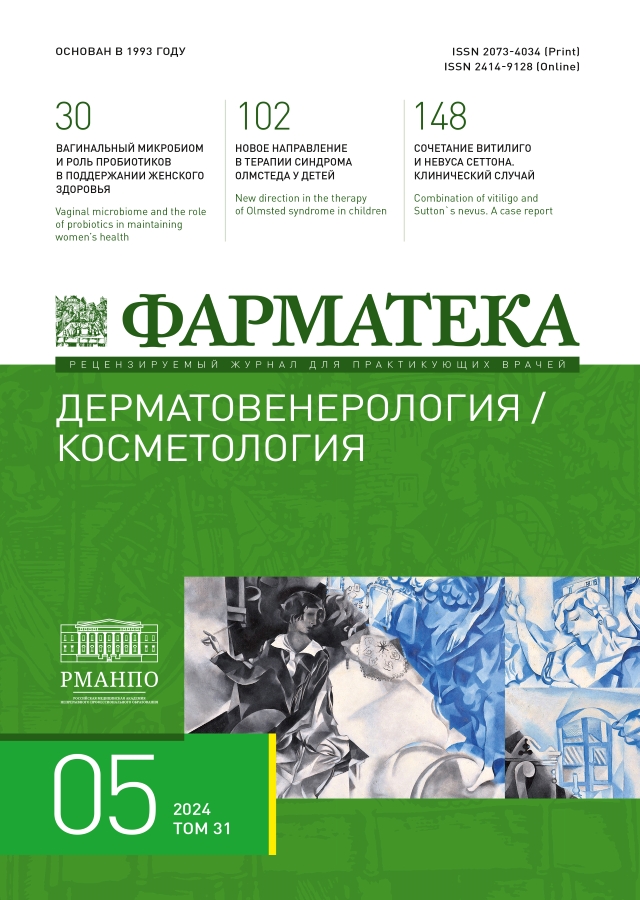Current approaches to the treatment of alopecia areata in children
- Autores: Pozdnyakova O.N.1, Nemchaninova О.В.1, Chasnyk A.S.2, Sklyanova E.Y.1, Reshetnikova T.B.1
-
Afiliações:
- Novosibirsk State Medical University
- Novosibirsk National Research State University
- Edição: Volume 31, Nº 5 (2024)
- Páginas: 72-75
- Seção: Clinical experience
- URL: https://journals.eco-vector.com/2073-4034/article/view/637473
- DOI: https://doi.org/10.18565/pharmateca.2024.5.72-75
- ID: 637473
Citar
Texto integral
Resumo
Alopecia areata (AA) resulting from an autoimmune attack on the hair follicle often debuts in childhood, which is one of the predictors of an unfavorable prognosis for the disease. In the case of manifestation of symptoms before puberty, half of children develop total alopecia. Currently, the treatment of children with AA does not have a generally accepted method and does not always meet expectations. The article discusses the data on current approaches to systemic and local therapy of AA published by specialists from different countries over the past few years.
Palavras-chave
Texto integral
Sobre autores
O. Pozdnyakova
Novosibirsk State Medical University
Email: sklyanova.elena@yandex.ru
ORCID ID: 0000-0003-1389-1001
Rússia, Novosibirsk
О. Nemchaninova
Novosibirsk State Medical University
Email: sklyanova.elena@yandex.ru
ORCID ID: 0000-0002-5961-6980
Rússia, Novosibirsk
A. Chasnyk
Novosibirsk National Research State University
Email: sklyanova.elena@yandex.ru
ORCID ID: 0009-0002-3663-1827
Rússia, Novosibirsk
E. Sklyanova
Novosibirsk State Medical University
Autor responsável pela correspondência
Email: sklyanova.elena@yandex.ru
ORCID ID: 0000-0001-6028-8585
Cand. Sci. (Med.), Associate Professor, Department of Dermatovenereology and Cosmetology
Rússia, NovosibirskT. Reshetnikova
Novosibirsk State Medical University
Email: sklyanova.elena@yandex.ru
ORCID ID: 0000-0002-6156-0875
Rússia, Novosibirsk
Bibliografia
- Fernandez L.T., Gomez-Flores M., Herz-Ruelas M.E., et al. Nail clippings microscopy in alopecia areata: An unexplored tool. J Eur Acad Dermatol Venereol. 2022;36(10):767–69. doi: 10.1111/jdv.18289.
- Lee H.H., Gwillim E., Patel K.R., et al. Epidemiology of alopecia areata, ophiasis, totalis, and universalis: a systematic review and meta-analysis. J Am Acad Dermatol. 2020;82:675–82. doi: 10.1016/j.jaad.2019.08.032.
- Wohlmuth-Wieser I., Osei J.S., Norris D., et al. Child-hood alopecia areata – data from the national alopecia areata registry. Pediatr Dermatol. 2018;35:164–69. doi: 10.1111/pde.13387.
- Rangu S., Rogers R., Castelo-Soccio L. Understanding alopecia areata characteristics in children under the age of 4 years. Pediatr Dermatol. 2019;36:854–58. doi: 10.1111/pde.13990.
- Клинические рекомендации «Гнездная алопеция». М., 2020. [Clinical guidelines «Alopecia areata». Moscow, 2020. (In Russ.)].
- Waskiel-Burnat A., Kolodziejak M., Sikora M., et al. Therapeutic management in paediatric alopecia areata: A systematic review. J Eur Acad Dermatol Venereol. 2021;35(6):1299–308. doi: 10.1111/jdv.17187.
- Peloquin L., Castelo-Soccio L. Alopecia Areata: An Update on Treatment Options for Children. Paediatr. Drugs. 2017;19(5):411–22. doi: 10.1007/s40272-017-0239-z.
- Özdemir M., Balevi A. Bilateral Half-Head Comparison of 1% Anthralin Ointment in Children with Alopecia Areata. Pediatr Dermatol. 2017;34(2):128–32. doi: 10.1111/pde.13049.
- Barton V.R., Toussi A., Awasthi S., Kiuru M. Treatment of pediatric alopecia areata: A systematic review. J Am Acad Dermatol. 2022;86(6):1318–34. doi: 10.1016/j.jaad.2021.04.077.
- Jung K.E., Gye J.W., Park M.K., et al. Comparison of the topical FK506 and clobetasol propionate as first-line therapy in the treatment of early alopecia areata. Int J Dermatol 2017;56:1487–88. doi: 10.1111/ijd.13676.
- Damsky W., Peterson D., Ramseier J., et al. The emerging role of Janus kinase inhibitors in the treatment of autoimmune and inflammatory diseases. J Allergy Clin Immunol. 2021;147(3):814–26. doi: 10.1016/j.jaci.2020.10.022.
- King B., Shapiro J., Ohyama M., et al. When to expect scalp hair regrowth during treatment of severe alopecia areata with baricitinib: insights from trajectories analyses of patients enrolled in two phase III trials. Br J Dermatol. 2023;189:666–73. doi: 10.1093/bjd/ljad253.
- Senna M., Mostaghimi M., Ohyama M., et al. Long-term efficacy and safety of baricitinib in patients with severe alopecia areata: 104-week results from BRAVE-AA1 and BRAVE-AA2. J. Eur Acad Dermatol Venereol. 2024;38:583–93. doi: 10.1111/jdv.19665.
- Piraccini B.M. A new era foralopecia areata: New treatments and improvedknowledge of the condition. J Eur Acad Dermatol Venereol. 2024;38:458–59. doi: 10.1111/jdv.19741.
- Brown L., Skopit S. An excellent response to tofacitinib in a pediatric alopecia patient: a case report and review. J Drugs Dermatol. 2018;17(8):914–17.
- Dai Y.X., Chen C.C. Tofacitinib therapy for children with severe alopecia areata. J Am Acad Dermatol. 2019;80(4):1164–66. doi: 10.1016/j.jaad.2018.12.041.
- Phan K., Lee G., Fischer G. Methotrexate in the treatment of paediatric alopecia areata: Retrospective case series and updated meta-analysis. Australas J Dermatol. 2019;61:119–24. doi: 10.1111/ajd.13206.
- Новиков К.А., Тамразова О.Б., Баграмова Г.Э. Применение иммуномодулирующих свойств эксимерного лазера 308 нм в терапии гнездной алопеции. Иммунопатология, аллергология, инфектология. 2017;1:46–51. [Novikov K.A., Tamrazova O.B., Bagramova G.E. Application of the immunomodulatory properties of the 308 nm excimer laser in the treatment of alopecia nervosa. Immunopathol. Allergol Infectol. 2017;1:46–51. (In Russ.)]. doi: 10.14427/jipai.2017.1.46.
Arquivos suplementares








